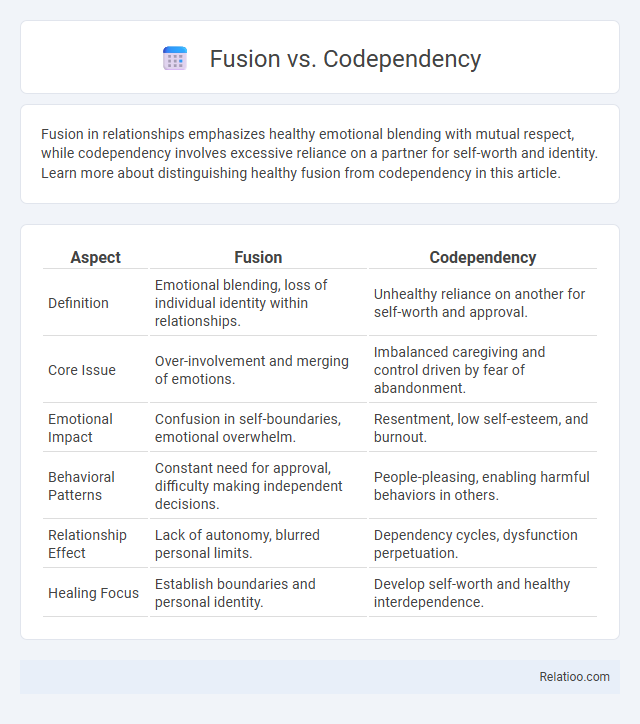Fusion in relationships emphasizes healthy emotional blending with mutual respect, while codependency involves excessive reliance on a partner for self-worth and identity. Learn more about distinguishing healthy fusion from codependency in this article.
Table of Comparison
| Aspect | Fusion | Codependency |
|---|---|---|
| Definition | Emotional blending, loss of individual identity within relationships. | Unhealthy reliance on another for self-worth and approval. |
| Core Issue | Over-involvement and merging of emotions. | Imbalanced caregiving and control driven by fear of abandonment. |
| Emotional Impact | Confusion in self-boundaries, emotional overwhelm. | Resentment, low self-esteem, and burnout. |
| Behavioral Patterns | Constant need for approval, difficulty making independent decisions. | People-pleasing, enabling harmful behaviors in others. |
| Relationship Effect | Lack of autonomy, blurred personal limits. | Dependency cycles, dysfunction perpetuation. |
| Healing Focus | Establish boundaries and personal identity. | Develop self-worth and healthy interdependence. |
Understanding Fusion and Codependency: Key Differences
Understanding fusion and codependency involves recognizing that fusion refers to a blurring of personal boundaries where individuals lose their sense of self in a relationship, whereas codependency is characterized by an excessive emotional or psychological reliance on a partner. Fusion often results in diminished autonomy and identity confusion, while codependency revolves around enabling behaviors and a need for approval or control. Your awareness of these key differences can help maintain healthier relational dynamics and personal boundaries.
Psychological Roots of Fusion and Codependency
Psychological roots of fusion often stem from early relational experiences where boundaries between self and others become blurred, leading to a diminished sense of individuality. Codependency arises from patterns of excessive emotional reliance on others for validation and self-worth, frequently rooted in dysfunctional family dynamics or trauma. Your understanding of these concepts can help differentiate between unhealthy emotional enmeshment (fusion) and the compulsive caregiving behaviors seen in codependency.
Signs and Symptoms of Fusion in Relationships
Signs of fusion in relationships include a blurred sense of personal identity, difficulty making decisions independently, and an overwhelming need for constant approval or validation from the partner. Individuals experiencing fusion often exhibit emotional enmeshment, where boundaries between self and partner are indistinct, resulting in heightened anxiety and decreased autonomy. Symptoms also involve chronic loss of self, emotional exhaustion, and a pattern of suppressing personal desires to maintain intimacy.
Behavioral Patterns of Codependent Relationships
Codependent relationships exhibit behavioral patterns such as excessive people-pleasing, enabling destructive habits, and sacrificing personal needs for the partner's well-being. Fusion, distinct from codependency, involves a loss of individual boundaries where partners overly merge identities and emotions, often leading to emotional enmeshment. Understanding these dynamics highlights the importance of establishing healthy boundaries to maintain autonomy and prevent unhealthy dependency in intimate connections.
Emotional Impact: Fusion vs Codependency
Fusion blurs the boundaries between individuals, leading to emotional entanglement where your sense of self becomes merged with another's feelings and thoughts. Codependency creates an unhealthy reliance where your emotional well-being depends heavily on pleasing or rescuing others, often resulting in frustration and burnout. Both patterns hinder emotional autonomy, causing confusion and distress in relationships but fusion specifically erodes individual identity, while codependency focuses on behavioral enmeshment and imbalance.
How Fusion Affects Personal Boundaries
Fusion blurs personal boundaries by causing individuals to lose their sense of self and overly merge their emotions and identities with others. In contrast, codependency involves an unhealthy reliance on another person for approval and self-worth, often sacrificing personal needs. Your ability to maintain clear boundaries is crucial to avoid fusion, ensuring emotional independence and healthier relationships.
Codependency and Its Effects on Self-Identity
Codependency often blurs the lines between your self-identity and the needs of others, leading to a diminished sense of autonomy and personal boundary confusion. This unhealthy reliance on external validation can result in difficulty making independent decisions and a persistent fear of abandonment, impacting emotional well-being. Understanding the contrast between fusion, where emotional states merge, and codependency, characterized by enabling harmful behaviors, helps clarify the distinct challenges each presents to self-identity development.
Healthy Relationship Alternatives to Fusion and Codependency
Healthy relationship alternatives to fusion and codependency emphasize maintaining personal boundaries and fostering individuality while nurturing connection. You can cultivate interdependence, where both partners support each other's growth and autonomy without losing their sense of self. Prioritizing open communication and emotional regulation strengthens trust and ensures balanced, fulfilling partnerships.
Strategies for Overcoming Fusion and Codependency
Overcoming fusion and codependency requires establishing firm personal boundaries and cultivating self-awareness to differentiate one's identity from others. Implementing strategies such as assertive communication, seeking individual therapy, and practicing self-care routines can restore emotional independence. Building healthy interdependence involves fostering mutual respect while maintaining autonomy in relationships.
Seeking Support: Therapy and Recovery Options
Seeking support through therapy can clarify the distinctions between fusion and codependency, helping you establish healthy boundaries and foster individual autonomy. Therapeutic approaches like cognitive-behavioral therapy (CBT) and dialectical behavior therapy (DBT) target patterns of enmeshment and promote emotional regulation, essential for recovery from fusion and codependency. Support groups such as Co-Dependents Anonymous (CoDA) provide community-driven healing and practical tools to reinforce your journey toward emotional independence and balanced relationships.

Infographic: Fusion vs Codependency
 relatioo.com
relatioo.com